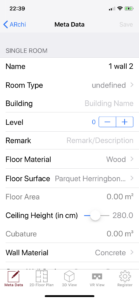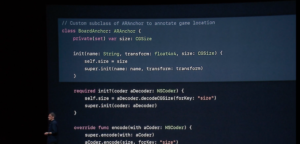react-native-ar/react-native-arkit
react-native-ar/react-native-arkit
react-native-arkit – React Native binding for iOS ARKit
react-native-arkit – React Native binding for iOS ARKit
Experimenting with world map registration on iOS 12 beta showed encouraging results.
I experimented with adapting the ARchi VR application, https://archi.metason.net. The world map registration part has been implemented in a separate iOS Framework, which was linked into the App.

In a registration view, the user is able to rotate the recorded walls, move all walls and edit individual points.
When loading a world map, during re-localisation, a screen shot is shown to the user to help find the right spot for ARKit to reload the scene.

After successful re-localisation, multiple tools are available to manually adapt the scene, to adde elements and to save the data and the world map.

Code available in ZHAW github (protected): https://github.engineering.zhaw.ch/u39575/ARchiVR.
Mid August – Mid November
Demo App for AR Cloud, indoor, e. g. navigation, info sharing. Details will be laid out separately.
Mid November
Decide if we can write a short paper for Eurographics https://www.eg.org/, 2019 https://www.eurographics2019.it/, short papers https://www.eurographics2019.it/index.php/for-submitters/short-papers/:
| December 14, 2018 | Submission deadline |
Mid January
Official demo app

Mobile app development is soaring high with Statista predicting that mobile applications will generate approximately $189 billion in…
Source: hackernoon.com/react-native-vs-real-native-apps-which-is-better-a8383d6f7ca5
Swift uses Automatic Reference Counting (ARC) to track and manage your app’s memory usage. In most cases, this means that memory management “just works” in Swift, and you do not need to think about memory management yourself. ARC automatically frees up the memory used by class instances when those instances are no longer needed.
Source: docs.swift.org/swift-book/LanguageGuide/AutomaticReferenceCounting.html

Developed by Apple, SwiftShot is an energetic and immersive multiplayer AR game built with key iOS technologies. Glimpse behind the curtain and see how SwiftShot was designed and developed using ARKit, SceneKit, and Swift. Understand the intricacies of designing great gameplay for AR, and learn practical techniques for multiplayer synchronization and physics simulation.
WWDC 2018 – Session 605 – iOS
Echt, aber nicht echt genug

Das viel gehypte Start-up Magic Leap hat die Entwicklerversion seiner Augmented-Reality-Brille fertiggestellt. Haben sich die Milliardeninvestitionen gelohnt?
Source: www.heise.de/tr/artikel/Magic-Leap-One-im-Test-Echt-aber-nicht-echt-genug-4131933.html
A scene graph node that serves as a placeholder for content to be loaded from a separate scene file.
https://developer.apple.com/documentation/scenekit/scnreferencenode

Our first hands-on experience with Magic Leap One. Please pardon the 240p video resolution; it was pulled from our mobile phone Periscope livestream. For all…
Learn how to easily create 3D scenes in your iOS apps or games in this Scene Kit tutorial!
Source: www.raywenderlich.com/2243-scene-kit-tutorial-getting-started